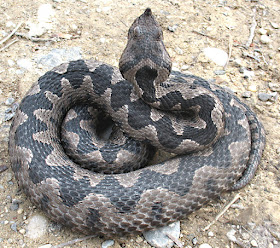Ceramic vase - Naqada II, Egyptian Predynastic period 3500 BC. Dim 8,5x7,6 cm. Currently in: Museo Arqueologico Nacional, Madrid, Spain...
Officially depicts a hunting scene...
Have you seen this article called "Nahal Mishmar hoard"? About the treasure throve of bronze objects found at Nahal Mishmar in Israel and dated 4000-3500 BC.
One of the artifacts found in the treasure is this beautiful staff...
It is topped with the 4 small heads of Ibex goats
surrounding the big central head of a Markhor goat
Now Ibex goats are found in Levant. And there they are a symbol of the rainy season, which starts when ibex goats start to mate, in Oct/Nov...Like on this depiction of the mother goddess from Revadim...
The problem is that Markhor goats don't live in Levant. They live in Central Asia, Iran, Iraq, Pakistan...Where they are a symbol of the rainy season, interchangeable with Ibex goat. Because both of their mating seasons start in Oct/Nov, when rains arrive...
I talked about this in my post "Goat in a tree"
So while researching Nahal Mishmar hoard, I proposed that the it must have been made by someone from that part of the world, Central Asia, Iran, Iraq, Pakistan. Cause only they could have seen Markhor goats and had it associated with Ibex goats as a symbol...
It turned out Nahal Mishmar treasure is believed to be made by immigrants from Iran. Because of genetics of the people who made the treasure...And the similarities of artifacts from both areas...
Now the makers of the Nahal Mishmar treasure were expelled by the locals...Those the locals couldn't kill. I thought they went back north to Iran. But what if they went the other way...Down south...To Egypt...
Who else could have made a vase with Markhor goats and Ibexes prancing around the mountains?
By the way, Ibex goats live in Egypt. It is the subspecies known as Nubian Ibex. And Nubian Ibex mating season is from October to December...
Guess what happens in Naqada in October? Rains arrive...
So I think that Ibex was depicted on the above vase for a reason. It is another example of Ibex goat being used as a calendar marker that means: rains arrive when Ibex goats start to mate...
Just like in Levant, Mesopotamia, Arabia, Central Asia, Iran...Amazing...
So I think that the guy with huge erection standing in the middle of mating Ibex and Bezoar goats is not a hunter. I mean he is unarmed which is usually a dead giveaway for "not a hunter". He is most likely a fertility symbol, fertility god, possibly rain god...
By the way this vase is not an exception. Markhor goats are found on other Naqada vases too. Like this one. Again no explanation how come this goat is here, in Egypt...
Ibex goats are also found all over predynastic artifacts. Here is another vase from Naqada II period. Dated to 3500BC.
It depicts Ibex goats...And Flamingos.
Why flamingos? Because breeding season of Greater Flamingo, the subspecies found in Egypt, is "Erratic, depending on the rains, but mainly November-February"...Ha!
As a comparison, here is a vase from Susa, Iran, dated to 4000BC...
In its center is a huge Ibex. Its horns surround what looks like a furrow with a plant, most likely grain. Rains make plants grow. And they start falling when Ibexes start mating...It is also "after the first rains" that fields are ploughed and grain is sown...Important!!!
The Susa vase also depicts pile of flamingoes...Flamingoes which arrive to Iran every November from Central Asia, to spend the winter...Interesting...Right?
Guess what happens in Egypt during the Ibex and Flamingos mating? Well grain is planted...The flood has ended, the soil was fertilized, and it's time to plough and plant grain while the first rain is falling...
What is amazing is that once we understand why these animals are depicted on the ancient artifacts, we can then detect anomalies in distribution of these artifacts: pieces that are found in the areas where the animals depicted don't exist...
Or the depicted scene put together makes no sense...When compared with the local climate...Which are all indicators of the foreign influence and possible migrations which brought these influences...
Like these vases.
Or this for instance
I talked about this in my post "An Ki = Ankh"
PS: Is it possible that the animal with the spiral horns is Kudu antelope? They lived in the North Africa, Levant and Arabia in the early and middle Holocene...Well at least this is what the authors of this paper think the animals with spiral horns depicted on the petroglyphs were...But were they Kudu's or Markhor goats? When did Kudus disappear from these areas? Were they still around in the 4th millennium BC? Did immigrants who came to Egypt from Mesopotamia bring Markhor goats with them? Via Arabia and Levant?



































